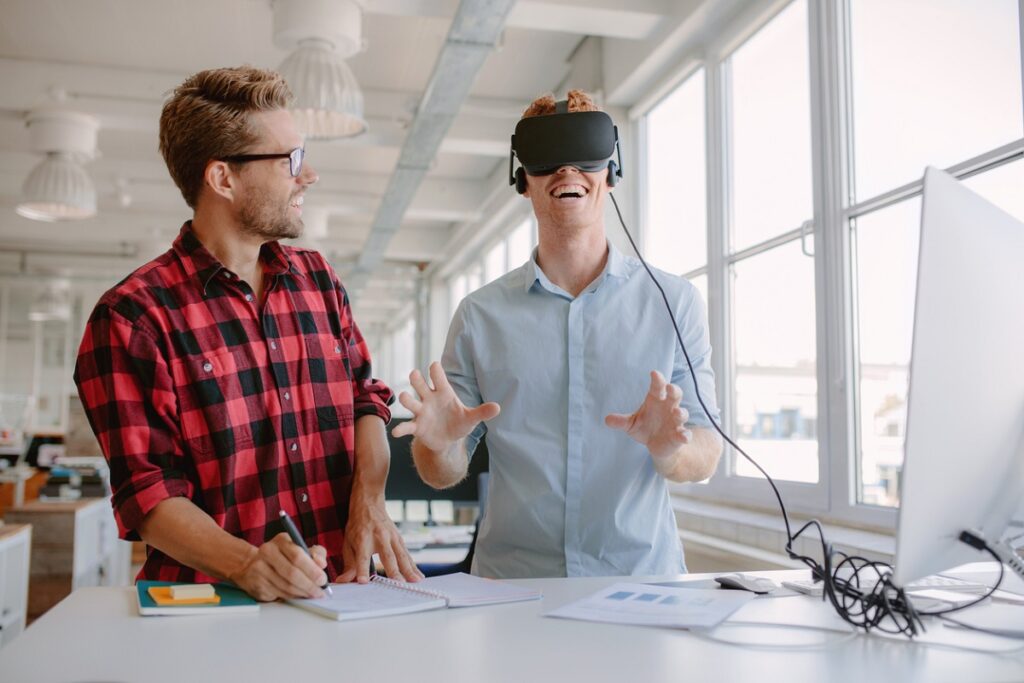When virtual reality content is experienced using a VR headset, the outcome is a virtual world. In that world, the possibilities are limited only by the imagination. This approach has given education an opportunity to leapfrog existing teaching practice by providing immersive experiences.
The first among these is that VR allows students to be absolutely captivated by the teaching. All teachers want their students to fully concentrate on their lesson, but teachers know that students do not, and sometimes cannot, concentrate that way. However, they will in their spare time devote many hours of concentration to gaming. Gaming late into the night on their consoles to reach the next level is common, but how many of those millions would do the same to study?
The playing of games for hours shows that people can easily concentrate for that length of time and that during that time they are learning - even though the lessons may seem meaningless outside the game itself. These lessons are absorbed without the player even realising it is happening.
Game on
Many gamers are keen users of VR headsets because they impart a deeper impression of the virtual world than a computer screen, through immersive interaction. The cost of these devices is becoming reasonable as the hardware and its application areas evolve; Google’s Cardboard VR glasses in combination with an application for instance cost very little money, while high-end devices with faster refresh rates, hand control, and motion capture are also becoming more affordable.
Transferring the lessons of gaming to an educational application means that students of any age can be fascinated by these virtual worlds; these can be deployed from pre-school through to tertiary education, and then continuously applied to in-work training.
The UK alone requires 70,000 new engineers every year to cover the current skills shortage, and a serious problem currently facing STEM education is that students learn each subject in isolation. In a world of work where cross-disciplinary and cross-organisational team skills are required this is an obvious disadvantage to job seekers and employers.
A serious problem currently facing STEM education is that students learn each subject in isolation.
Dassault Systèmes is working with several universities to develop solutions to overcome this problem. This involves international teams of STEM students combining their different disciplines in real-time on the same projects. This is supported by using 'intelligent’, cloud hosted 3D models as a shared and unifying resource to collaborate around.
Working in cross-disciplinary teams means communicating, sharing and combining experiences & skills. Learning this way makes the students more employable, due to their educational experience and acquired set of skills closely matching their eventual work environment.
Virtual worlds of STEM
The use of virtual worlds can easily supplement traditional chalk and talk lessons, and replace 2D presentation that many students find uninspiring.
Stepping into a virtual world shows students the what, how and why that make learning interesting and compelling. VR can be applied to most learning and is particularly appropriate for teaching STEM subjects, or training people for engineering work. This is because of the highly-realistic 3D visualisation content, including animated 3D simulations of very complex products, processes and systems.
Students can for example work on a virtual aero engine without the need to have a real one. The cost implications are considerable, because not only is it more cost-efficient to use a virtual engine, but the risk of damage or harm is greatly reduced as well. Plus, a whole class of trainees can simultaneously work on the virtual model of an engine and see it in all the detail they need to fully understand it. Its operation can be simulated so that students can even be inside the engine as it is working; this is impossible in real-life and takes learning experience to a new level.
The cost implications are considerable, because not only is it more cost-efficient to use a virtual engine, but the risk of damage or harm is greatly reduced as well.
Currently Dassault Systèmes is partnering with thousands of educational establishments and courses at all levels, including 40 British universities where design, architecture and engineering are benefitting from the universal language of 3D. Across the world up to 5 million students currently encounter our digital simulation capabilities, with the 3D experience as part of their education programme.
One project in a school for young engineers uses stereoscopic 3D visualisations of a car, a motorbike and a vintage vehicle to immerse students in the virtual world, where they can understand and envisage theoretical concepts in way that makes it fun and engaging to learn. So far, secondary education students have created virtual representations including a design for a fishing reel, a mixer, a land speed record beating vehicle, and a mechanical hand.
Home work
Using virtual content and VR hardware allows students to work on their projects at a distance from their place of education – to effectively take the lesson away and work on that aero engine or any other project at home. This means students can develop their studies and overcome weaknesses in the same environment that they were using at school, college or work. Just like gaming, they achieve instant feedback and rewards while moving up to the next level.
Training for work uses the same approach: to create virtual environments where people can experience dangerous and hazardous activities – without any risk to themselves or others. Setting up a nuclear power station, a deep mine or an oil refinery with its full detail in the virtual world means people can learn processes and practice safely as many times as they need to, while gaining the confidence and experience required to operate in the real world. This kind of training lets people experience virtually any event such a leak, a flood or a fire while learning how to deal with it.
Just like gaming, they achieve instant feedback and rewards while moving up to the next level.
Another example is the Living Heart project: based on the patient data, a virtual heart is created that gives medical professionals the opportunity to simulate its specific activities, as well as the operation of blood, nerves, stents and pacemakers. This is a major advance for doctors, surgeons and device manufacturers who can at last see the individual heart and its malfunctions – virtually and from within.
Life force
Subjects beyond STEM can also benefit greatly from virtual worlds. History can be re-created and brought back to life, physical and social geography modelled, creatures virtually re-animated. The introduction of AI could be used to simulate a board room, a courtroom or any other encounter.
The low cost and speed of creating and deploying virtual worlds for education means that in India, using VR has become part of the Digital India and Skills India programmes that include thousands of training partners, and up to 55 million students who learn and train towards the dream of making India the skills capital of the world.
The introduction of AI could be used to simulate a board room, a courtroom or any other encounter.
There has been a revolution in the past few years, with advanced software applications and hardware technologies becoming available to ´anyone´. The next years will see that more and more people are educated in a variety of ways using virtual worlds to see and experience the real world and study in new, more comprehensive ways. Its power to teach is well proven while its educational and training potentials are literally unlimited.











2 Responses
The implications that VR has
The implications that VR has for learning and development is quite honestly staggering. This technology never fails to amaze me. Having the ability to see the inside of an engine and see all the moving parts is going to offer a whole new learning experience as well as a deeper level of understanding on the work being studied. Awesome!
Another benefit of virtual
Another benefit of virtual reality is the fact that training can be less expensive. You have to spend a lof ot money if you have to transport a big group of employees from various parts of country. Using virtual reality you can train large numbers of people within a virtual setting without spending vast amounts of money.